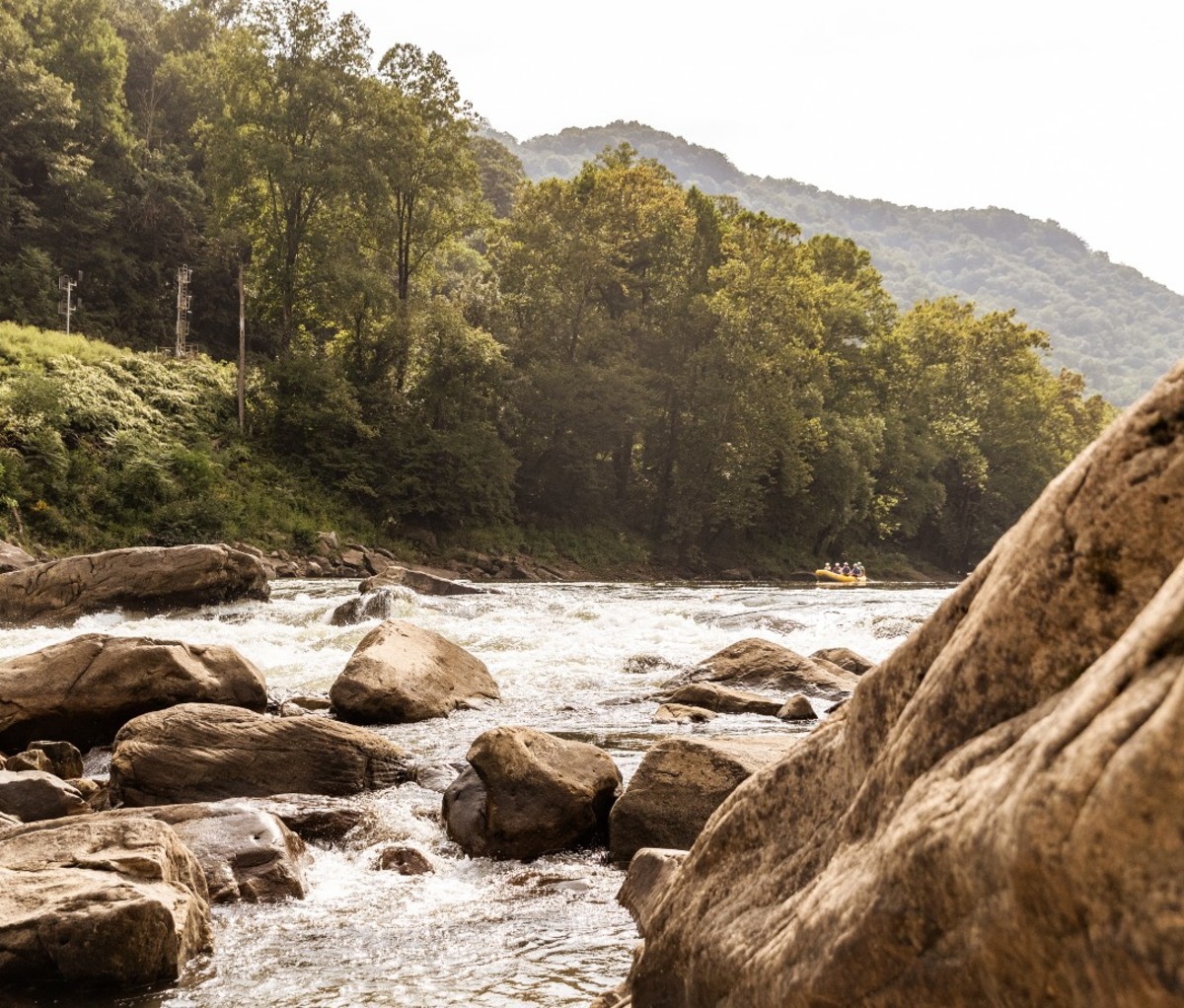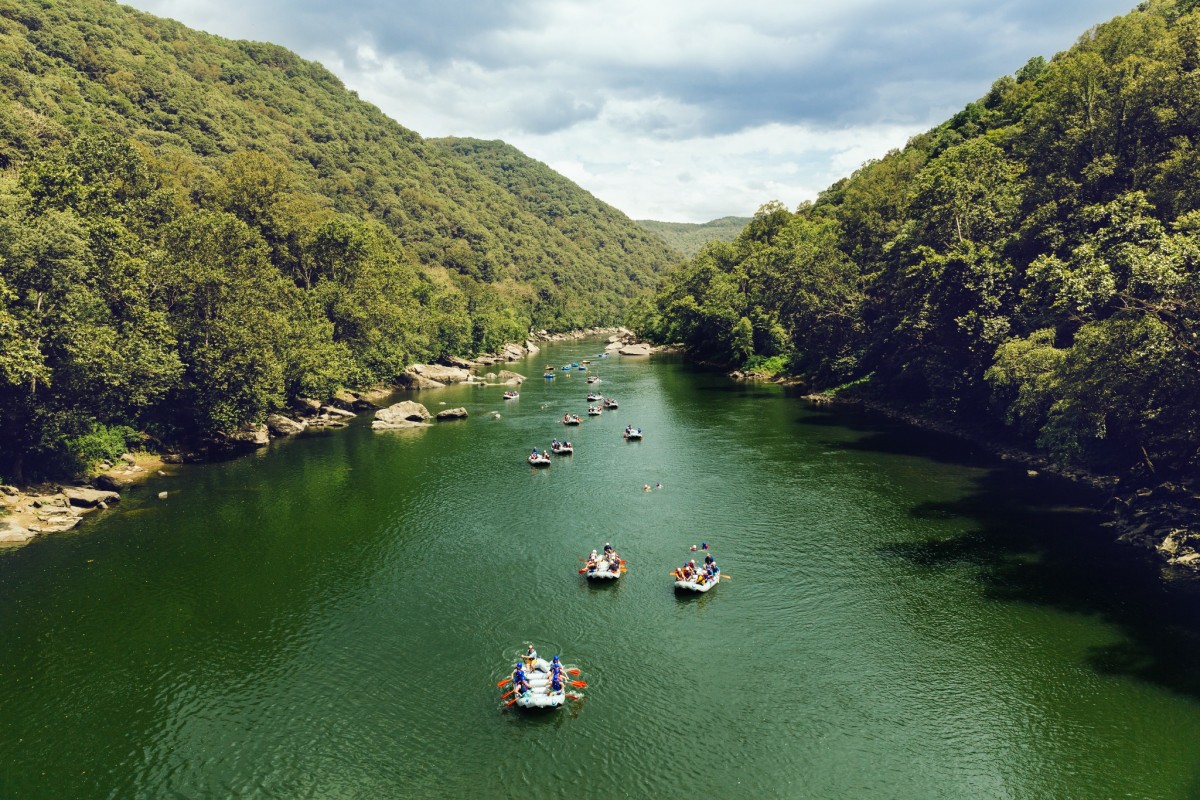This article was produced in partnership with West Virginia Department of Tourism
There are plenty of places where the geography is right for whitewater rafting, but very few are as perfect as the New River Gorge area of West Virginia. Over millions of years, water pouring out of the Appalachian Mountains carved two incredible river canyons, right next to each other—New and Gauley. High volume, steep gradient, with plenty of ledges, cliffs and boulders, the two rivers offer some of the most challenging and exciting recreational rafting in the country.
“What’s really so special here is that we have a whole weekend of whitewater rafting so close,” says Chelsea Bricker, from Adventures on the Gorge, one of the main raft companies in the area. “The fact they also have such dependable flows makes it even more unique.”
The New River has the longest rafting season on the east coast. Guided boat trips begins in April and the river peaks soon after. While the water is cold, it’s high and moves fast, creating long wave trains and huge hydraulic features—some big enough to stand a 16-foot raft on its end. This is the only time of year when raft trip operators, like Adventures on the Gorge and ACE Adventure Resort, run both the Upper and Lower sections of the river in a full day of soaked-head-to-toe rafting.
By Memorial Day, the river level is dropping and the water is warming up. The Upper section becomes family-friendly, but the Lower remains challenging through summer and into fall with plenty of Class IV rapids running through New River Gorge National Park, the nation’s newest national park.
“It feels really wild,” says Haynes Mansfield, marketing director of ACE Adventure Resort. “In a lot of places, rafting is the only way to see many parts of the gorge.” Mansfield says rafting the Lower New is perfect training for the main event of East Coast paddling: Gauley Season.

“If you’re a paddler, you hope you’re good enough to paddle the Gauley River one day,” he says. “It’s one of the most difficult commercially rafted rivers in the country.” And possibly the only one guaranteed by a federal “whitewater rafting law.”
Most of the year, the Summersville Dam restricts the Gauley’s flow to a trickle, but a federal law mandates ideal rafting releases for six weekends in September and October. With 2,800 cubic feet per second of water crashing down, the 24-mile Gauley turns into a frothing roller coaster with 50 major rapids, including eight Class V cataracts, the most difficult and powerful rapids raft companies can paddle.
Like the New River, the Gauley breaks down into two sections. The Upper is the most demanding, says Mansfield, with over 50 rapids crammed into just 12 miles. There’s Pillow Rock, where most of the river crashes into a giant boulder—and cheeky rafters challenge themselves to tap the rock with their paddles—and Sweet’s Falls, a 14-foot drop that skirts a recirculating pour-over and a submerged boulder that’s tossed more than a few paddlers into the air.
Lost Paddle is the longest rapid, with three sections that string together into a fast-moving rush of waves, boulders, and hydraulics that requires continuous maneuvering. It’s so challenging, rafters must be at least 16 years old and previous rafting experience is highly recommended.
“You’ll absorb more of the experience if you’ve rafted Class IV before,” explains Mansfield. The scenic and remote-feeling Lower Gauley may be mellower, but that’s only a relative comparison, he says. It still has over 40 rapids including three Class V cataracts. Possibly the most technical section on the whole river is Mash, a long boulder garden strewn with hazards. And the Lower ends with a bang at the Class V Pure Screaming Hell rapid, a pinball run through rocks and a giant holes.

Raft companies like ACE and Adventure on the Gorge help make the most of Gauley Season with raft and stay packages, which include various camping, cabin and chalet options, and a full menu of paddling choices on both the Gauley and New rivers. Someone new to rafting could make long weekend out of it and run the Lower New on Friday, the Lower Gauley Saturday and Upper Gauley on Sunday, says Bricker. Another progression is to do a Reverse Gauley: Lower Gauley as a warmup for the Upper on day two.
For those with some experience who want a wilderness experience, Bricker recommends an overnight trip, which tackles the Upper and Lower Gauley in a continuous push with a night of camping on the river, deep in the canyon. And for maximum adrenaline, nothing touches the Double Run, paddling the Upper twice in one day.
It’s a lot to choose from, but Mansfield says it’s hard to go wrong when it comes to rafting in southern West Virginia. In fact, arguably the most important choice is where to relive the day’s adventure. There’s Smokey’s on the Gorge. The restaurant’s perched on the edge of New River Gorge, looking out at its famous bridge. Locavores should head to ACE’s Lost Paddle Bar and Grill, which features West Virginia-inspired cocktails and microbrews. And for a local favorite, head to Pies and Pints in Fayetteville for can’t-miss pizzas.
“When you’re done playing, nothing beats a drink and meal with friends,” Mansfield says. “It’s the best way to finish a great day of rafting.”
from Men's Journal https://ift.tt/omnl8Rv


0 comments